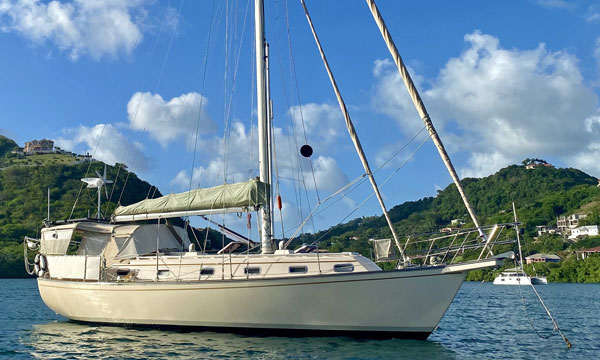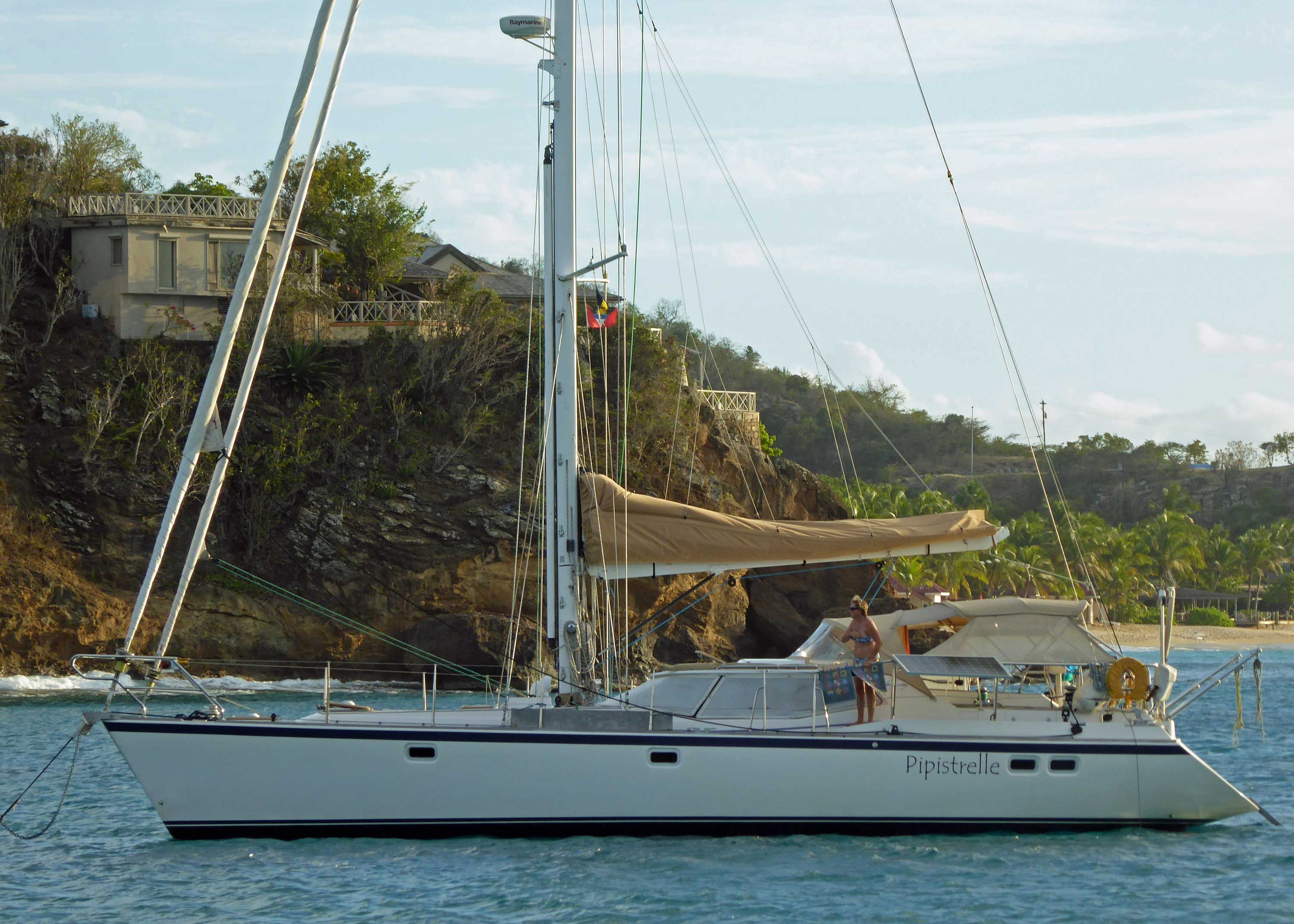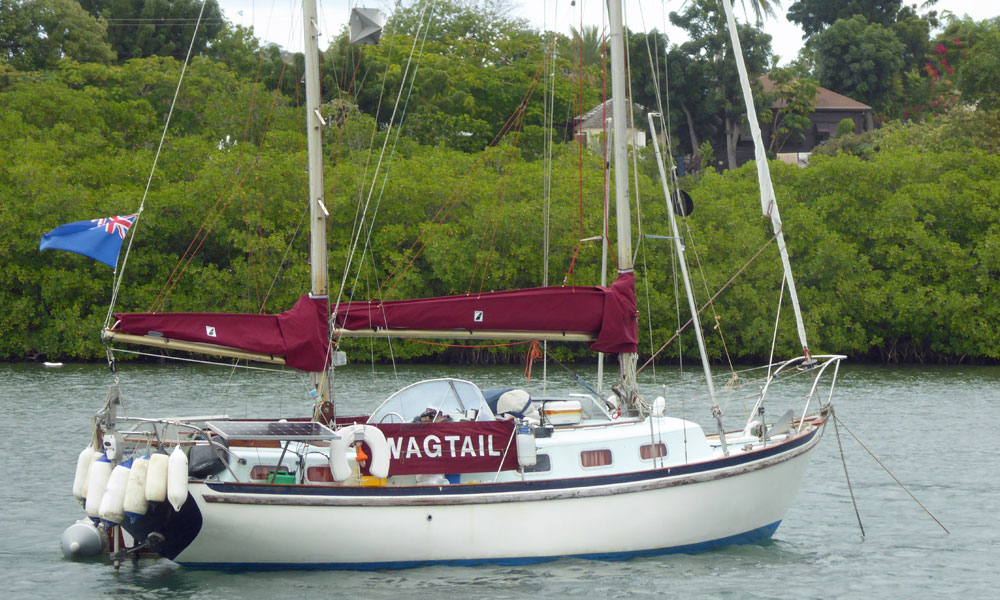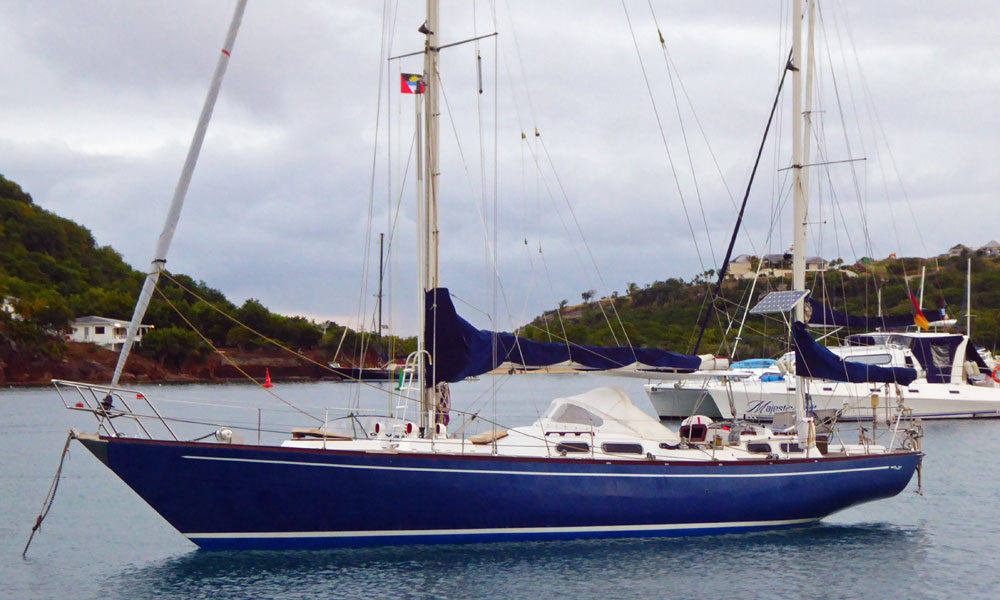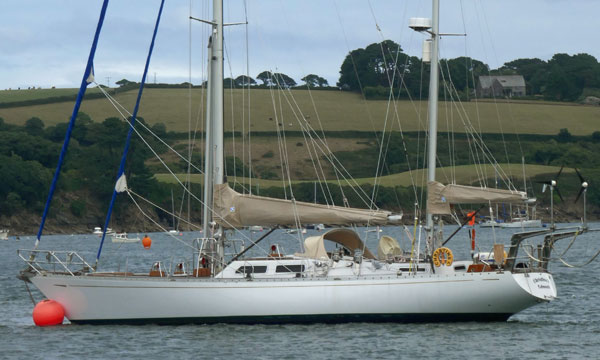- Home
- Types of Sailboats
The Ultimate Guide to Sailboats & Rigs: Sloops, Ketches & More
In a Nutshell...
The world of sailboats is a vast and varied one, with each rig designed for a specific purpose. This guide offers a comprehensive overview of the most common sailboat types, providing the knowledge you need to understand the fundamental differences between monohulls and multihulls. We'll explore everything from the simplicity of a sloop to the complexity of a schooner, detailing the pros and cons of each. By the end of this article, you’ll have a clear understanding of the design philosophies behind these classic and modern rigs.
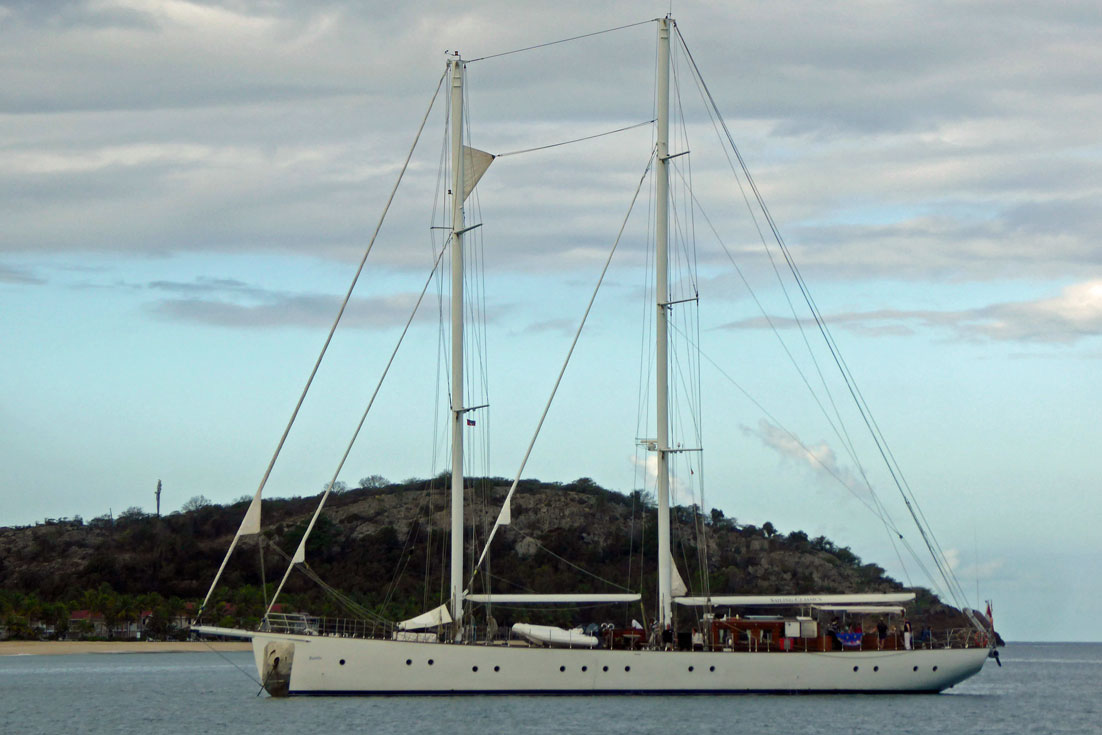 The Schooner 'Kairos', She will look absolutely stunning under full sail
The Schooner 'Kairos', She will look absolutely stunning under full sailTable of Contents
Monohulls vs. Multihulls: One hull or two, or maybe three?
Before we get into the specifics of different rigs, we need to address the most fundamental difference between sail boat types: a single hull or multiple hulls.
Monohulls
Monohulls are the traditional sailboat design, featuring a single hull with a keel for stability. They are the boats you likely picture when you think of sailing—they heel over in the wind, providing a classic sailing feel.
Pros
- They are generally more affordable to buy and maintain.
- Offer excellent upwind performance.
- Can be easier to handle in marinas.
Cons
- Can feel less stable and have less deck and interior space compared to multihulls of a similar length.
..........
Multihulls
Multihulls, which include catamarans (two hulls) and trimarans (three hulls), are a more modern evolution of sailboat design.
Pros
- They are incredibly stable, don't heel, and offer vast living spaces.
- Impressive speed, especially on a reach.
Cons
- Have a wider beam, which can make them more expensive to dock and haul out.
- Tend to be less nimble upwind and can be tricky to maneuver in tight quarters.
Still not convinced either way? Maybe you'd like to take a look at The Catamaran vs Monohull Argument...
Sloop, Catboat & Cutter Rigs: The Cruising Workhorses
The vast majority of sailboats you see today, particularly in the cruising world, fall into these categories. They all feature a single mast, but with key differences in their sail plan.
The Sloop
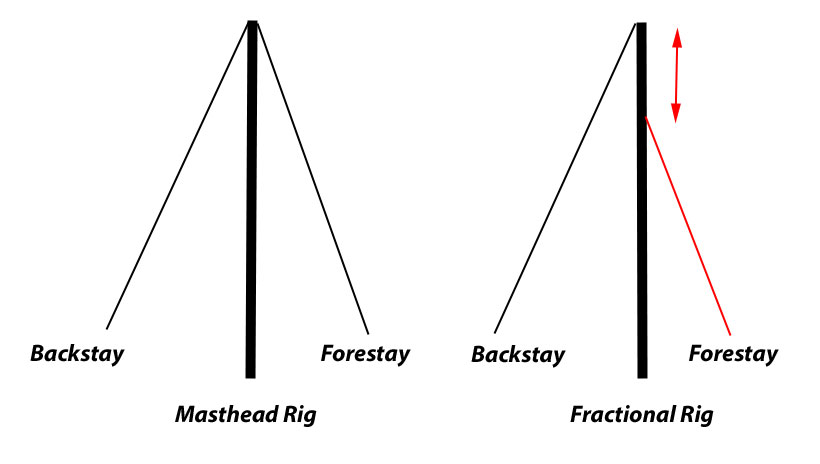
This is the most common and simplest rig. It has one mast, one mainsail, and one headsail (jib or genoa). The rig is efficient and easy to manage, but there are two main variations you need to know about: masthead and fractional.
As a cruising sailor, I've found that the simplicity of a sloop is both its greatest strength and its greatest weakness.
While it's wonderfully easy to set sail, a big genoa on a masthead sloop (less so with a fractional rig) can be a real handful to furl in a sudden squall when you're shorthanded.
Dick McClary
- Masthead Sloop: In this traditional configuration, the forestay—the wire supporting the mast from the bow—attaches at the very top of the mast. The headsail is a large sail, often a genoa, that provides the majority of the boat's power. It is a sturdy and simple rig, favored on many cruising boats from the 1960s and 70s.
- Fractional Sloop: A more modern and performance-oriented rig where the forestay attaches to the mast at a point below the very top (typically 7/8 or 9/10 of the way up). This leaves the top section of the mast unsupported, which allows it to be bent or "tuned" with the backstay to flatten the mainsail in stronger winds. This rig is often found on racing and newer high-performance cruising boats.
Pros
- Simple to operate.
- Excellent upwind performance.
- A large number of available boats on the market.
Cons
- The sail plan offers fewer options for balancing the boat in varying wind conditions.
- On larger boats, the single headsail can be a monster to handle.
For a deeper dive into whether this is the right choice for your next boat, see our article, Is a Sailing Sloop the Best Rig for Cruising?
..........
The Catboat
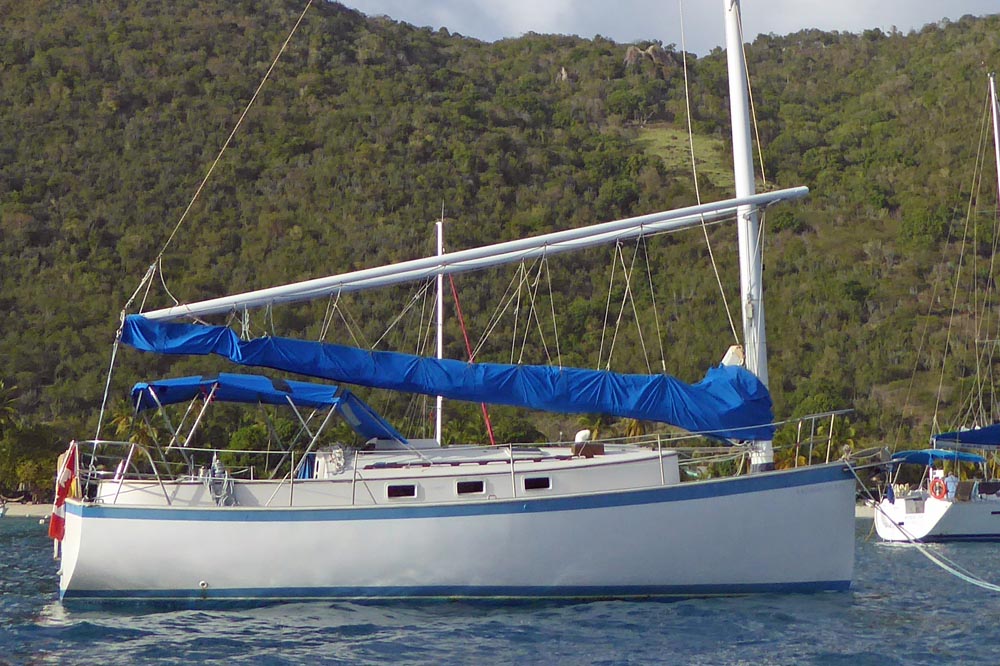 A Catboat—this one's a Nonsuch 30 with a wishbone rig
A Catboat—this one's a Nonsuch 30 with a wishbone rigI've always appreciated the elegance of a catboat's simplicity. While they might not win any races, there's a unique joy in sailing a boat where you can be ready to go in minutes with just one sail to manage.
They're perfect for gunkholing in protected bays and estuaries, but I've chatted with several skippers in the Caribbean that have sailed theirs over from the UK.
Dick McClary
A classic American design, the catboat is the epitome of sailing simplicity. It features a single unsupported mast stepped way up in the bow and a single sail (often gaff-rigged) with no jib. Its distinctive features are its wide beam and shallow draft, making it perfect for coastal and shallow-water cruising.
Pros
- Incredible simplicity, minimal rigging, huge interior volume for its length.
- Shallow draft for exploring skinny water.
- Easy to rig and single-hand.
Cons
- Poor upwind performance compared to other rigs.
- The single, large sail can be a handful in strong winds.
- The wide beam can also be a challenge in some marina slips.
..........
The Cutter
A cutter rig is a variation of the sloop with a single mast but two headsails—a jib on the forestay and a smaller staysail set on an inner forestay.
Pros
- The split headsail plan gives you tremendous flexibility.
- In a blow, you can drop the jib and sail on just the staysail and a reefed main, a wonderfully balanced and powerful combination. This is why a cutter is often the preferred rig for serious offshore cruising.
Cons
- There’s more rigging to manage on deck.
- Tacking can be a bit more work as the staysail needs to be sheeted in separately.
My personal preference for cruising is the cutter rig, and I've detailed my reasons in Why the Cutter Rig Sailboat Is My First Choice for Cruising.
I also explore the specific differences with another popular rig in Is the Cutter Rig More Useful than the Solent Rig for Offshore Cruising?
Ketch, Yawl & Schooner Rigs: Blue-Water Specialists
When you add a second or third mast, you move into the world of blue-water cruisers. These rigs are designed to be powerful yet manageable on long ocean passages.
The Ketch
I once helped a cruising couple sail their newly-purchased ketch from Mallorca to Gibralter and truly appreciated this rig's versatility.
When a squall hit unexpectedly, we were able to quickly drop the mainsail and continue sailing under the headsail and mizzen, maintaining control and making for a much safer and more comfortable ride.
Dick McClary
A ketch has a main mast and a second, shorter mast called a mizzen mast, which is positioned forward of the rudder post. This splits the sail area into smaller, more manageable units.
Pros
- This rig allows for a greater variety of sail combinations, which is perfect for matching the sail plan to changing wind conditions without excessive effort.
- In a heavy wind, you can drop the main and sail on the headsail and mizzen ("jib and jigger").
Cons
- The added mast and rigging increase maintenance and cost.
- The mizzen mast can also interfere with the cockpit layout.
If you're considering a ketch for your next boat, I offer some further insights in Does a Ketch Sailboat Make a Good Cruising Boat?
..........
The Yawl
A yawl is very similar to a ketch but with a crucial distinction: its mizzen mast is located aft of the rudder post. This mast is generally smaller than a ketch’s mizzen, and its sail, known as a jigger, is more for balancing the boat and trimming than for providing significant forward thrust. The yawl is a beautiful and classic rig, though less common today.
Pros
- The jigger sail helps to balance the helm, making the boat easier to steer and more stable on a long passage, especially when the main is reefed or dropped.
Cons
- The mizzen mast is often so far aft that it can be a nuisance for anyone sitting in the cockpit.
- The sail itself provides very little propulsion.
..........
The Cat-Ketch
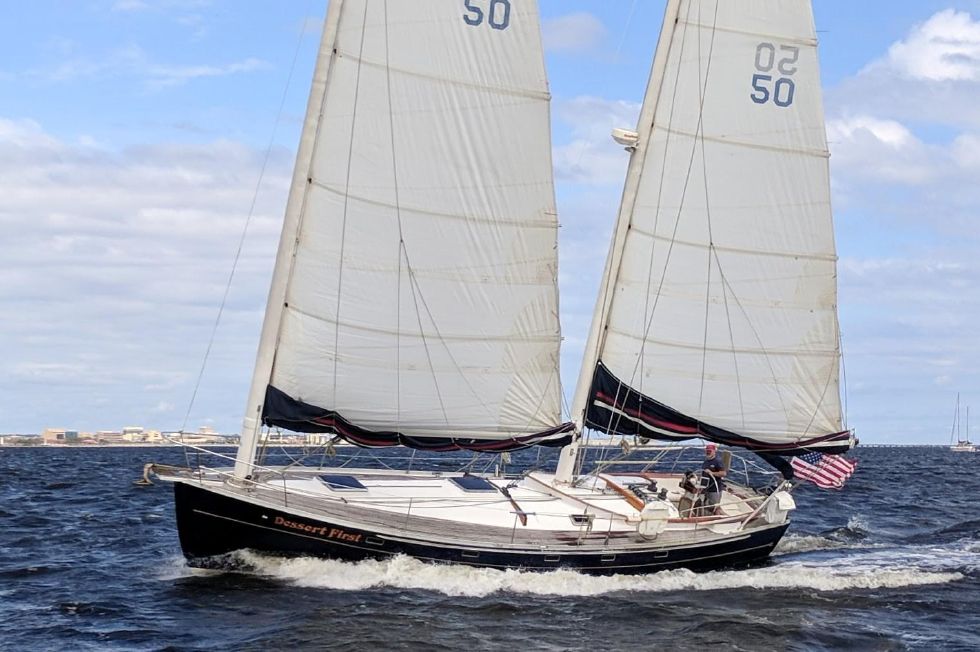 A Freedom 44 cat-ketch
A Freedom 44 cat-ketchThere's a lot of debate in the sailing community about the effectiveness of unstayed rigs. In my experience, they can be surprisingly capable.
I've seen cat-ketches handle lively conditions with a grace that a conventional rig might struggle to match, thanks to the simplicity of their sail plan.
Dick McClary
The cat-ketch is a unique rig with two unstayed masts (meaning they are not supported by wires) and no headsail. The mainmast is forward, and a shorter mizzenmast is aft, much like a traditional ketch, but without the complex web of rigging.
Pros
- Extreme simplicity and ease of handling, particularly for single-handing.
- Since there's no headsail to tack, you simply turn the boat, and the sails take care of themselves.
- The unstayed masts also reduce windage.
Cons
- Upwind performance can be less efficient than a traditional cutter or sloop.
- The rig can also be less powerful in light winds.
For a more in-depth look at this particular rig, a good resource is our article, Do The Unstayed Rigs Of Cat Ketch Sailboats Really Work?
..........
Staysail Ketch
A variation of the ketch, a staysail ketch has the same two-mast configuration but also includes an inner forestay for a staysail, much like a cutter. This rig offers the most versatile sail plan for a monohull, making it a powerful and highly adaptable option for serious offshore voyaging.
..........
The Schooner

A schooner has two or more masts, with the foremast being the same height or shorter than the aft mast. While less common on modern recreational boats, schooners are iconic and powerful sailing vessels.
Pros
- With a large number of sails, they can be balanced beautifully for various points of sail.
- They are magnificent to look at and offer a truly classic sailing experience.
Cons
- Schooners are complex and require a skilled crew.
- The large number of sails and lines means a lot more work, making them a poor choice for shorthanded sailing.
Catamarans & Trimarans: Speed, Stability & Space
Multihulls offer a radically different sailing experience. They don’t heel over and their stability makes them incredibly comfortable for long-term living and cruising.
Catamarans
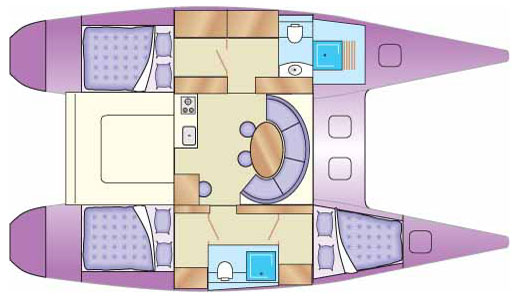 Voluminous accommodation in a typical catamaran layout
Voluminous accommodation in a typical catamaran layoutWith two parallel hulls, catamarans provide immense deck and interior space. They are often chosen for their stability, shallow draft, and high speed potential, making them popular for charter businesses and liveaboards.
Pros
- Exceptional stability.
- Large living space, and great visibility from the helm.
Cons
- Wide beam can limit marina access and increase docking fees.
- Upwind performance is not as good as a monohull.
If you’re drawn to the spaciousness and stability of a catamaran for long passages, we have a detailed guide in Can a Catamaran Sail Boat be a Good Choice for Cruising?
..........
Trimarans
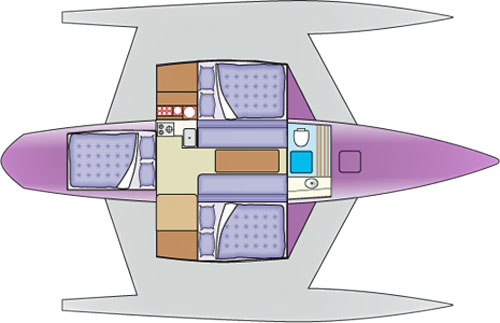 But not so much living space in a similarly-sized trimaran
But not so much living space in a similarly-sized trimaranTrimarans feature a central main hull and two smaller outrigger hulls. They are known for their speed and exhilarating sailing performance.
Pros
- Extremely fast and stable, offering a thrilling sailing experience.
Cons
- The folding amas (outrigger hulls) can be a point of failure.
- They have a very wide beam, making them challenging to find a slip for.
For a side-by-side comparison to help you choose the right multihull for your sailing style, read our guide, Trimaran vs. Catamaran: Finding Your Ideal Multihull.
Which Sailboat is Right for You? Making a Decision
The choice of a sailboat rig is deeply personal. Here’s a simple comparison to help guide you:
| Rig Type | Ideal Use | Key Advantage | Key Disadvantage |
|---|---|---|---|
| Sloop | Coastal & Day Sailing, Racing | Simple & efficient | Less versatile in heavy weather |
| Catboat | Shallow-water Coastal Cruising, Day Sailing | Extreme simplicity & shallow draft | Poor upwind performance |
| Cutter | Offshore Cruising | Versatile sail plan | More complex to rig & handle |
| Ketch | Long-distance Cruising | Easily managed sail area | Higher maintenance & cost |
| Yawl | Offshore Cruising | Balances the helm | Mizzen provides little power |
| Cat-ketch | Shallow-water cruising, Single-handing | Extreme simplicity and ease of handling | Less efficient upwind performance |
| Schooner | Classic Sailing, Large Vessels | Powerful & majestic | Requires a large crew |
| Catamaran | Coastal Cruising, Liveaboard | Stability & space | Wide beam & higher docking fees |
| Trimaran | Performance Sailing | High speed & exhilarating | Complex & limited marina options |
This article was written by Dick McClary, RYA Yachtmaster and author of the RYA publications 'Offshore Sailing' and 'Fishing Afloat', member of The Yachting Journalists Association (YJA), and erstwhile member of the Ocean Cruising Club (OCC).
Frequently Asked Questions (FAQs)
What is the main difference between a sloop and a cutter?
What is the main difference between a sloop and a cutter?
A sloop has a single headsail on the forestay, whereas a cutter has two—a jib and a staysail—allowing for a more versatile and easily managed sail plan, especially in heavy weather.
What is a catboat and how is it different from a cat-ketch?
What is a catboat and how is it different from a cat-ketch?
A catboat is a single-masted vessel with a single sail. A cat-ketch, on the other hand, is a two-masted vessel that also sails without a headsail. While both rigs prioritize simplicity, the cat-ketch distributes its sail area across two masts.
What is the difference between a ketch and a yawl?
What is the difference between a ketch and a yawl?
The difference is the placement of the mizzenmast. On a ketch, the mizzenmast is located forward of the rudder post, while on a yawl, it is located aft of the rudder post. A ketch's mizzen provides more power, while a yawl's is primarily for trimming and balancing the boat.
Are catamarans really faster than monohulls?
Are catamarans really faster than monohulls?
Generally, yes. Catamarans have less hull displacement and a wider beam, which allows them to achieve higher speeds, particularly on a reach. Their speed comes from their design, not their sail area.
What is the benefit of a ketch rig for cruising?
What is the benefit of a ketch rig for cruising?
A ketch's mizzenmast and sail break up the total sail area into smaller, more manageable parts. This makes it easier to balance the boat and reef sails without a lot of effort, which is ideal for shorthanded sailing on long passages.
Is a schooner a good boat for single-handing?
Is a schooner a good boat for single-handing?
Schooners, with their multiple masts and large sail plans, are generally not considered ideal for single-handed sailing. They require a larger crew to manage the sails effectively, especially during maneuvers.
Resources Used
- nauticed.org: Sloop vs Cutter vs Ketch: Which Rig Is Right for You?
- dockwalk.com: Sloop vs. Ketch: Which is Better?
- schoonersail.com: How To Tell The Difference Between A Ketch And A Schooner
- yachting.com: All About Ketch Sailboats: From Rigging to Majestic Beauty
- britannica.com: Yawl
- wavetrain.net: CRUISING SAILBOAT RIGS: Ketches, Yawls, and Schooners
- yachting.com: Yawl Sailboats: Elegance, Tradition, and Timeless Sailing
- catboats.org: What is a Catboat?
- yachtingworld.com: Why is the Catboat so Versatile?
- sailingtotem.com: The Cat Ketch Rig
- boatingmag.com: Why Choose a Cat Ketch?
Recent Articles
-
Modern Boat Electronics and the Latest Marine Instruments
Dec 20, 25 05:27 PM
Should sailboat instruments be linked to the latest boat electronics as a fully integrated system, or is it best to leave them as independent units? -
Hans Christian 43: Classic Bluewater Cruiser & Liveaboard Sailboat
Dec 10, 25 04:37 AM
Explore the Hans Christian 43: a legendary heavy-displacement, long-keel sailboat. Read our in-depth review of its specs, design ratios, and suitability for offshore cruising and living aboard. -
Planning Your Sailboat Liveaboard Lifestyle: An Ocean Sailor's Guide
Dec 06, 25 05:18 AM
Seasoned sailors share their methodical risk analysis for planning a secure Sailboat Liveaboard Lifestyle, covering financial, property, and relationship risks.
